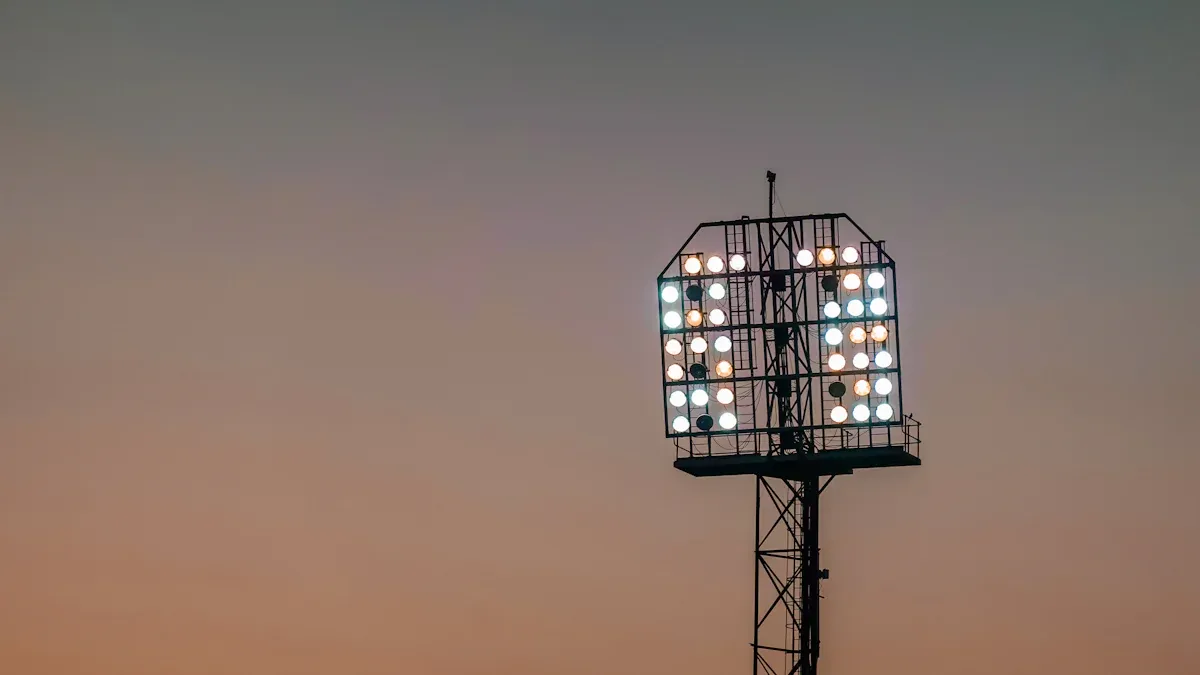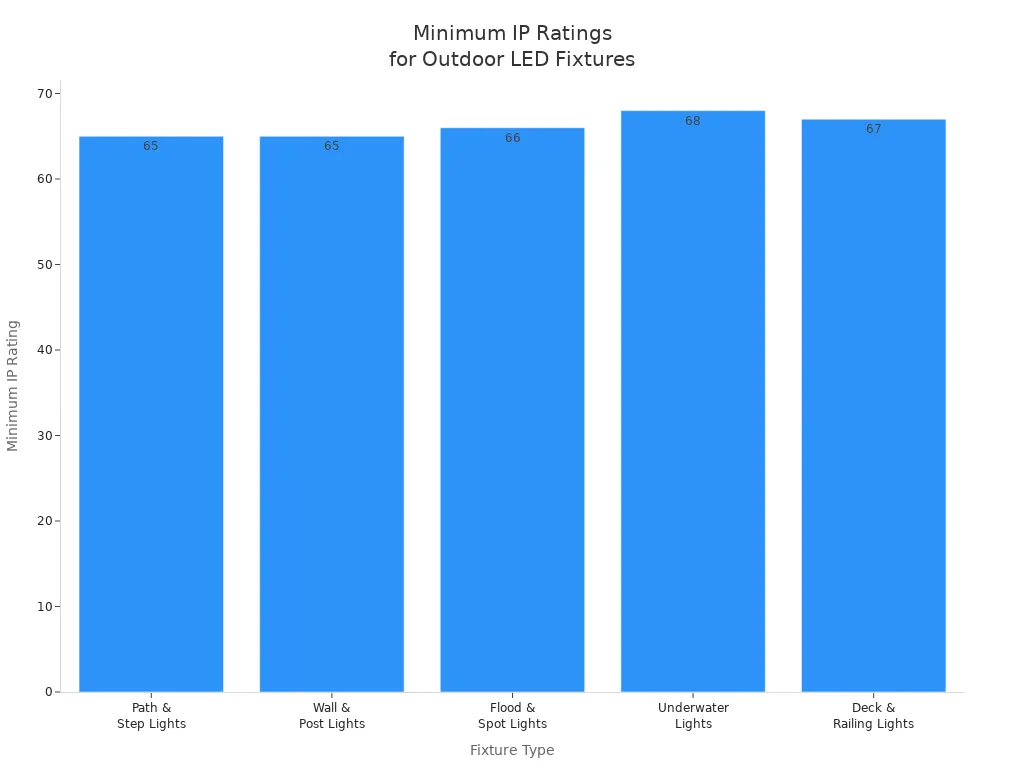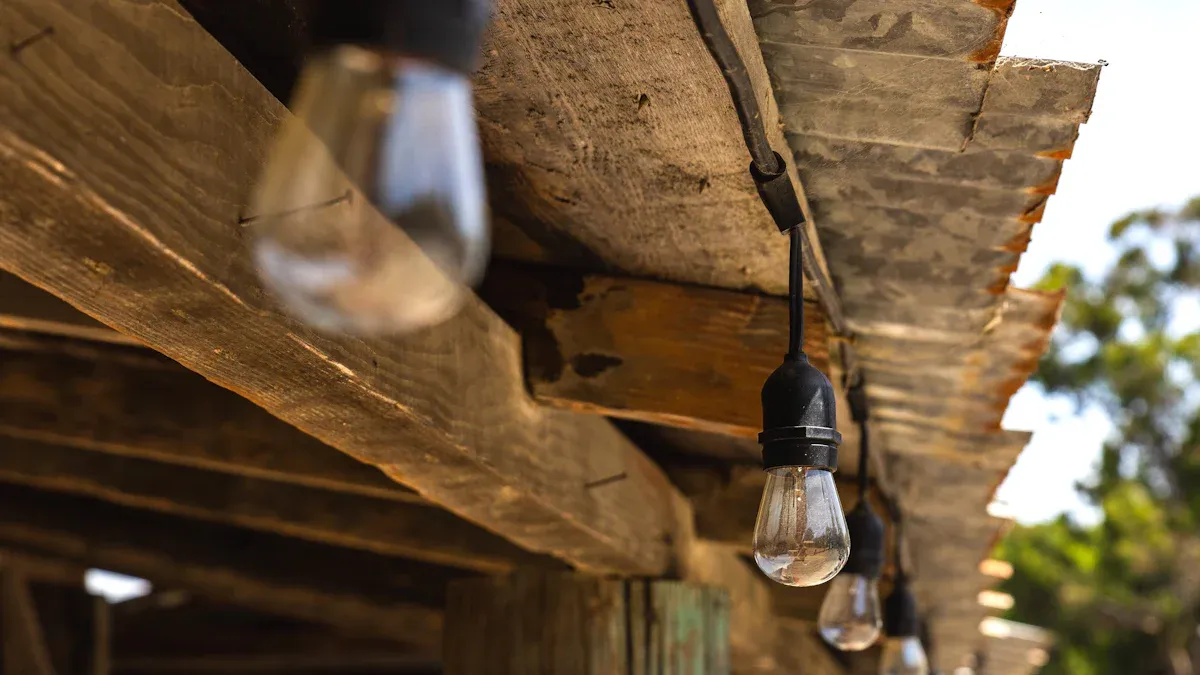Outdoor LED Fixtures

Outdoor LED Fixtures help you light up your Home’s yard, driveway, or business entrance with ease. You can use them for landscape beauty, safety at night, or to show off your building’s style. These lights stand up to weather and last much longer than older types. Take a look at this quick comparison:
Lighting Type | Average Lifespan (hours) | Energy Savings (%) |
|---|---|---|
LED | 50,000+ | 75% less than incandescent, 50% less than fluorescent |
You find options for every Product need and budget. Learn more About Us to see how you can save money and enjoy bright outdoor spaces.
Key Takeaways
Outdoor LED Fixtures use much less energy than regular bulbs. They help you save money on your electricity bills. They can use up to 80% less power.
These fixtures last a very long time. They can work for 25,000 to 100,000 hours. You do not need to replace them often.
LED lights are strong and can handle bad weather. They work well outside in rain or snow.
Good outdoor lighting helps keep people safe. It can stop crime and lets you see better at night.
Picking the right fixtures can make your property look nicer. It helps make guests and customers feel welcome.
Benefits Of Outdoor LED Fixtures
Efficiency & Savings
Do you want to pay less for electricity? Outdoor LED Fixtures help you save money. LEDs use less power than older bulbs. Look at this table to see how much energy you can save:
Lighting Type | Average Wattage | Estimated Hours Per Day | Annual Energy Use (kWh) |
|---|---|---|---|
LED Bulb | 10 Watts | 5 Hours | 18.25 |
Incandescent Bulb | 60 Watts | 5 Hours | 109.5 |
Halogen Bulb | 43 Watts | 5 Hours | 78.48 |
LEDs can use up to 80% less energy than halogen bulbs. Many businesses save 30-50% on energy after switching to Outdoor LED Fixtures. At home, you will see lower bills too.
💡 Tip: If you own a business, switching to LEDs can cut lighting costs by about 40% each year.
Longevity & Low Maintenance
Changing bulbs often is annoying. Outdoor LED Fixtures last much longer than other lights. Here is a quick look:
Lighting Type | Average Lifespan (hours) |
|---|---|
LED | 10,000 to 25,000 |
Halogen | 2,000 to 4,000 |
Incandescent | 700 to 2,000 |
Some LED lights last up to 100,000 hours! You spend less time changing bulbs and more time enjoying your bright yard or entrance.
You also save money on new bulbs and repairs. LEDs keep working for years, so you do not need to fix them often.
Durability & Weather Resistance
Outdoor LED Fixtures are made to last. They work in rain, snow, and heat. You want lights that work in any weather. Here are some common weatherproof ratings:
Fixture Type | Minimum IP Rating | Why? |
|---|---|---|
Path & Step Lights | IP65 | Resist rain, sprinklers, and foot traffic debris |
Wall & Post Lights | IP44 - IP65 | For covered or fully exposed locations |
Flood & Spot Lights | IP66 | Handle rain and dirt near ground level |
Underwater Lights | IP68 | Withstand continuous submersion |
Deck & Railing Lights | IP67 | Face splashing, snow buildup, or cleaning sprays |

Pick fixtures with a high IP rating, like IP65 or higher, so they keep working in all weather. Many Outdoor LED Fixtures use strong metals like aluminum or stainless steel. They have sealed parts to block water and dust.
Safety & Security
You want your home or business to be safe at night. Outdoor LED Fixtures help a lot. Bright lights help you see better and keep strangers away.
"Lighting improves visibility and decreases concealment in public settings, thus contributing to increased safety." – Haans & de Kort, 2012
A city in New Jersey put in LEDs and saw fewer violent crimes. Good lighting helps stop crime almost as much as police do. Motion-activated LED lights work even better. When a light turns on, it can scare away intruders and make them easy to see.
Evidence Description | Impact |
|---|---|
Motion sensor placements led to a 70% drop in attempted break-ins when combined with cameras. | 70% reduction in break-ins |
60% of convicted burglars would avoid properties with security lighting. | 60% avoidance rate |
A security expert says motion-activated lights can lower your risk of break-ins.
Aesthetic Enhancement
You want your yard or building to look nice all the time. Outdoor LED Fixtures help you show off your home, garden, or business. Good lighting can highlight trees, flowers, or building details. It makes guests and customers feel welcome.
Lighting designers use LEDs to make places look great.
Good lighting can show off special features and set the mood.
Many homeowners feel happier after adding outdoor lighting.
You can use Outdoor LED Fixtures to create cool effects and make your yard or building stand out.
There are many styles and colors, so you can find the best look for your space.
Types Of Outdoor LED Fixtures

Flood Lights
You see flood lights almost everywhere. They light up big spaces like parking lots, stadiums, and building walls. These lights give strong, wide beams that help you see clearly and stay safe. Many cities use flood lights to lower crime and make outdoor areas feel secure. Take a look at how different flood lights work:
Type of Flood Light | Typical Applications |
|---|---|
Outdoor LED Flood Lighting | Security, vehicle and pedestrian use, building wall washing, sports activities, general outdoor illumination |
Stadiums and sports arenas use flood lights for clear viewing and safe play.
Parking lots get brighter and safer, with crime rates dropping by up to 39%.
Wall Packs
Wall packs go on the sides of buildings. You use them to light up walkways, entrances, and loading docks. These fixtures stand up to tough weather and keep working for years. They spread light evenly, so you do not get dark spots. Here are some features you might like:
Feature | Description |
|---|---|
Rugged Design | Built to handle rain, snow, and wind. |
Light Distribution | Focuses light to cover large areas and boost safety. |
Variety of Styles | Matches your building’s look and adds curb appeal. |
LED wall packs give you bright, steady light that makes outdoor spaces safer.
You spend less time fixing them because they last longer.
Pathway & Landscape Lights
Pathway and landscape lights help you see where you walk. They guide guests and show off your yard’s best features. You can use them to make your home feel cozy and safe. Here’s what these lights do for you:
Benefit Type | Description |
|---|---|
Improved Visibility | Lights up paths and steps, lowering accident risk. |
Guided Navigation | Helps guests find their way, even at night. |
Enhanced Security | Keeps away 70% of intruders by lighting up dark spots. |
Creates Ambiance | Soft glow sets a relaxing mood for evenings. |
Highlights Landscaping | Shows off trees, flowers, and garden features. |
Boosts Curb Appeal | Makes your home look better and can raise its value by up to 5%. |
Extends Living Space | Lets you use your yard more, even after sunset. |
Security & Motion-Activated Lights
Security lights protect your home or business. Motion-activated lights turn on when someone walks by. You do not need to flip a switch. These lights scare off intruders and save energy. Here’s how they work:
Motion-activated lights switch on when they sense movement.
They help keep entryways and driveways safe.
Standard outdoor lights stay on or use timers, but they do not react to movement.
Motion detector lights make patios and paths safer by lighting up only when needed.
Tip: If you want extra security, try motion-activated lights near doors and garages.
Decorative & Solar Options
Decorative and solar lights add style and save energy. You can pick fun shapes, colors, or patterns to match your space. Solar lights use sunlight, so you do not need wires or extra power. Here are some pros and cons:
Advantages | Limitations |
|---|---|
Mood and elegance | Seasonal power supply |
Easy to install and remove | Depends on weather |
Saves money and helps the planet | May need extra lighting on cloudy days |
Solar lights cost less over time and help the environment.
You can set them up quickly and move them if you want.
On rainy days, solar lights may not shine as bright.
Outdoor LED Fixtures come in many types, so you can find the best fit for your yard, business, or garden.
Choosing Outdoor LED Fixtures
Assessing Needs & Space
You want your outdoor lighting to work for you, not against you. Start by thinking about why you need lights outside. Are you trying to make your yard safer at night? Do you want to show off your garden or make your patio feel cozy? Maybe you need bright lights for security or just want to help guests find their way.
Here’s a quick checklist to help you figure out what you need:
Purpose of the lighting (safety, looks, or making things easier)
Size and layout of your space
How bright you want it
Color temperature for the right mood
Energy efficiency to save money
Weather resistance for tough conditions
How easy it is to install
If you want to light up a big area, you might need several fixtures. Look at where trees, fences, or furniture sit. These things can block light or make shadows. Try to picture how your space will look at night with the lights on.
Tip: Walk around your yard after dark. Notice where you trip or where it feels too dark. That’s where you need more light.
Brightness & Color Temperature
Picking the right brightness and color temperature makes a huge difference. You don’t want lights that are too harsh or too dim. The brightness, measured in lumens, tells you how much light you get. Color temperature, measured in Kelvin (K), changes how the light feels.
Here’s a table to help you choose:
Brightness Level | Application | Color Temperature (Kelvin) | Effect |
|---|---|---|---|
Low Lumens | Pathway lights | 2700K-3000K | Warm, inviting glow for homes |
High Lumens | Flood lights | 4000K-5000K | Cooler, neutral light for security and business |
You can pick from these color temperatures:
Cool White (5000K-6500K): Great for security. Makes everything look bright and clear.
Daylight White (4000K-5000K): Good for general lighting. Helps you see well.
Neutral White (3500K-4000K): Works almost anywhere. Balances warm and cool.
Warm White (2700K-3500K): Feels cozy. Perfect for relaxing or showing off plants.
If you want a welcoming feel, go for warm white. If you need to see everything clearly, choose cool or daylight white.
Weatherproof Ratings
Outdoor lights face rain, snow, dust, and heat. You want fixtures that can handle it all. Look for the IP rating, which tells you how well the fixture keeps out water and dirt. The higher the number, the better the protection.
Here’s what the ratings mean:
IP44: Handles light rain. Good for covered spots.
IP65: Keeps out heavy rain and dust. Works almost anywhere.
IP66: Tough enough for storms and dirt near the ground.
IP68: Can go underwater. Perfect for ponds or fountains.
Note: Always check the IP rating before you buy. If you live where it rains a lot or gets really cold, pick a fixture with IP65 or higher.
Design & Budget
You want your lights to look good and fit your wallet. Design matters because you want your outdoor space to match your style. Some people like modern fixtures. Others want something classic or fun. Think about the color, shape, and size.
Budget is important too. LED fixtures cost more at first, but they save you money over time. You use less electricity and change bulbs less often. If you have a tight budget, start with the most important areas. You can add more lights later.
Homeowners often care about how the lights look and work. Businesses might focus on safety and saving money. No matter what, make sure you pick fixtures that last and do what you need.
Tip: Write down your top three needs before you shop. This helps you stay focused and pick the best Outdoor LED Fixtures for your space.
Installation Tips

Safety Precautions
Before you start, always put safety first. You want to avoid shocks and keep your lights working for years. Here’s what you should do:
Turn off the power at the breaker before you touch any wires.
Use a voltage tester to make sure no electricity is flowing.
Seal all connections tightly so water can’t get in.
You also want to use weather-resistant fixtures and protect your wires with outdoor-rated materials. Make sure your outlets have GFCI protection to prevent shocks. Keep lights away from anything that could catch fire. If you’re not sure about something, it’s smart to ask an electrician.
Safety Precaution | Description |
|---|---|
Use weather-resistant fixtures | Pick lights that handle rain, snow, and heat. |
Install GFCI outlets | These outlets stop shocks if water gets in. |
Protect wires | Use weatherproof conduits and seal connections. |
Avoid circuit overloads | Don’t use too many lights on one circuit. |
Consult professionals | Call an expert if you feel unsure. |
Wiring & Setup
Planning helps you get the best results. Map out where you want your lights. Decide which areas need more brightness or color. Hide wires by mounting tracks under eaves or along fences. Connect your LEDs to a power source and control box. This lets you set up zones and adjust settings. Always test your system before you finish to make sure everything works.
Tip: Use slim, color-matched tracks to keep wires out of sight and your yard looking neat.
Placement Strategies
Where you put your lights matters. Place them to cover walkways, driveways, and entrances. Use reflective covers to spread light farther. Mount lights at the right height and angle to avoid dark spots or glare. Don’t let beams overlap too much. Check your lights often and clean them so they stay bright.
Strategy | Description |
|---|---|
LED Placement | Put lights where they cover the most area and reduce shadows. |
Height and Angles | Adjust height and tilt for the best coverage. |
Reflective Covers | Use covers to boost brightness without more energy. |
Regular Adjustments | Move and clean lights as needed for top performance. |
DIY vs. Professional
You might want to install lights yourself, or you might need help. DIY works well for small projects, like a few path lights. If you have a big yard or want lots of zones, a professional can save you time and trouble. Experts know how to handle wiring and tricky setups. They also help you avoid costly mistakes.
Consideration | Professional Installation | DIY Installation |
|---|---|---|
Project Scope | Best for large or complex jobs | Good for small, simple projects |
Skill Level | Needs expert knowledge | Works for experienced DIYers |
Time and Budget | Saves time, may cost more upfront | Cheaper at first, but risky |
Long-Term Value | Boosts property value and reliability | May not last as long |
If you ever feel unsure, don’t risk it—call a pro. Your safety and peace of mind matter most.
Maintenance & Troubleshooting
Cleaning & Care
You want your outdoor LED fixtures to stay bright and last longer. Taking care of them helps a lot. Here is an easy routine you can follow:
Clean your fixtures often. Use a soft brush or cloth to wipe off dust and dirt. Do not use rough things, so you do not scratch them.
Trim plants and bushes near your lights. If bushes grow too much, they block the light and make shadows. Keep them short for the best light.
Check your lights often. Look for cracks, rust, or water inside. Finding problems early helps you avoid big repairs.
Check seals and gaskets. Make sure they are tight and keep water out. This protects your lights from getting wet.
Tip: Set a reminder to check your lights every few months. You can find problems before they get worse.
Common Issues
Sometimes, outdoor LED fixtures have problems. You can fix many of these yourself. Here is a quick guide:
Issue | Solution |
|---|---|
Heat Management | Make sure your fixture has good airflow and a proper heat sink. |
Unresponsive Remote Controls | Try new batteries, move things blocking the signal, or reset the receiver. |
Inconsistent Color Temperature | Use LEDs from the same batch and change the settings. |
Water Damage | Use waterproof fixtures and check for leaks often. |
Sudden Brightness Drop | Check the power supply, add cooling, or replace bad parts. |
Clean often, install fixtures the right way, and pick the best type for your space. |
If your lights flicker or look dim, check the power and clean the fixture first. Most problems are easy to fix.
Replacement & Upgrades
LED fixtures last a long time, but not forever. Sometimes, you need to get new ones or upgrade. You might see new models with better features or notice your old lights do not match anymore. Here are signs you should change your lights:
LED fixtures do not last forever, and even good brands can stop working early. When you look for new fixtures, you might find the old ones are not made anymore. This can make your lights look different in color or finish. This means you may need to replace fixtures sooner than you thought, especially if they are not easy to update.
Indicator | Explanation |
|---|---|
Obsolescence | New LED technology comes out fast. Old fixtures may use more energy or look old. |
Early Failures | Some fixtures stop working after just a few years. |
Compatibility Issues | New lights might not match the style or specs of your old ones. |
If your lights look faded, do not match, or stop working, it is probably time for an upgrade. You will get better lights and a new look.
Comparing Outdoor Lighting Options
LED vs. Halogen
When you look at LEDs and halogen lights, you see big differences. LEDs win in almost every way. Here’s why:
LEDs use up to 80% less power than halogen bulbs for the same amount of light. You save a lot on your energy bill.
You can expect LEDs to last 25,000 to 50,000 hours. Halogen bulbs only last 2,000 to 4,000 hours. That means you change halogen bulbs much more often.
LEDs cost more at first, but you save money over time. You buy fewer replacements and use less electricity.
Halogen bulbs waste energy as heat. LEDs turn most of their energy into light, so they stay cool and safe to touch.
Halogen flood lights might cost less to buy, but their higher energy use and short life make them more expensive in the long run.
💡 Tip: If you want to save money and avoid hassle, choose LEDs for your outdoor spaces.
LED vs. Incandescent
Incandescent bulbs used to be everywhere, but LEDs have taken over. Check out this quick comparison:
Feature | LED Fixtures | Incandescent Lights |
|---|---|---|
Average Lifespan | 25,000–50,000 hours | ~1,000 hours |
Wattage | 8W–15W (as bright as 60W) | 100W |
Energy Efficiency | Up to 80% less electricity | High energy use |
Annual Consumption | 44 kWh (15W for 8 hours) | 292 kWh (100W for 8 hours) |
Maintenance Frequency | Fewer replacements needed | Replace bulbs often |
You will notice LEDs last much longer and use a lot less power. You spend less time changing bulbs and more time enjoying your lights. LEDs also handle outdoor weather better, so you do not have to worry about them breaking as often.
LED vs. CFL
CFLs (compact fluorescent lamps) were once a popular energy-saving choice. Now, LEDs do even better. Here’s what you should know:
LEDs can last up to 50,000 hours. CFLs usually last 7,000 to 10,000 hours. You replace CFLs much more often.
LEDs use less energy than CFLs and turn more power into light, not heat.
CFLs contain mercury, which means you need to be careful when you throw them away. LEDs do not have this problem, so they are safer for the environment.
With LEDs, you get less waste and fewer trips to the store for new bulbs.
🌱 Note: If you want a greener, longer-lasting light for your yard, LEDs are the best choice.
You get more light for less money with Outdoor LED Fixtures.
These lights last longer and handle tough weather.
You can use them to make your yard or business look great.
Ready to brighten up your space? Try Outdoor LED Fixtures for your next outdoor lighting project.
FAQ
How long do outdoor LED fixtures last?
You can expect most outdoor LED fixtures to last between 25,000 and 50,000 hours. Some high-quality models keep shining for up to 100,000 hours. You change bulbs less often and save money over time.
Can you install outdoor LED fixtures yourself?
Yes, you can handle simple installations like pathway lights. For bigger jobs or wiring, you should call a professional. Safety matters most, so always turn off the power before you start.
Do outdoor LED lights work in rain and snow?
Outdoor LED fixtures with a high IP rating, like IP65 or higher, work well in rain and snow. You get reliable lighting even during storms. Always check the product’s weatherproof rating before you buy.
Are outdoor LED fixtures expensive?
You pay more upfront for outdoor LED fixtures, but you save money on energy and maintenance. LEDs use less electricity and last longer than older bulbs. Over time, you spend less.
Can you use solar-powered LED lights outside?
Absolutely! Solar-powered LED lights work great for gardens, pathways, and patios. You don’t need wires or extra power. On cloudy days, they might be dimmer, but they still help you save energy.
See Also
Why LED Signs Are Superior To Other Outdoor Ads
Key Tips For Creating Impactful LED Outdoor Signage
Selecting Ideal Outdoor Lighting Fixtures For Your Business

